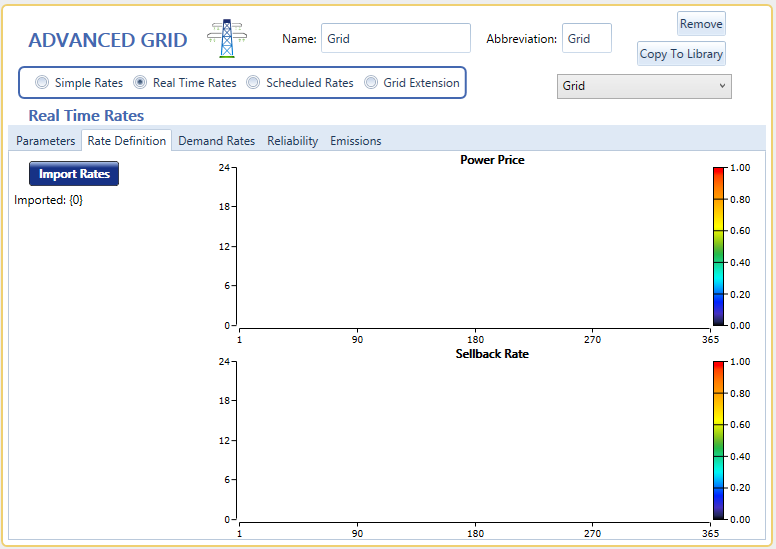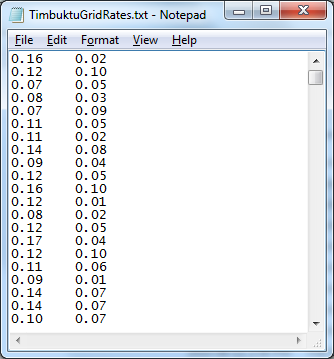
HOMER Pro 3.15

![]()
Important: This option is part of the Advanced Grid module. See Adding Modules for more information on purchasing modules.
Real Time Rates models grid power prices that can change from time step to time step. On the Advanced Grid page, select the Real Time Rates radio button to choose this mode. In this mode, you can control many prices and limits under the Parameter tab (described below). You can import time-series price data under the Rate Definition tab (described below). You can also define demand charges, grid outages, and grid emissions under the Demand Rates, Reliability, and Emissions tabs, respectively.
Parameters
The Parameters tab allows you to set capacity, optimization, and control parameters.
Control Parameters
The following options affect when the system is able to buy from or sell to the grid.
|
Control |
Description |
|
Prohibit grid from charging battery above price of ($/kWh) |
If enabled, this prevents the grid from charging the battery if the grid power price is above the specified value |
|
Prohibit any battery charging above price of ($/kWh) |
If enabled, this prevents any battery charging if the grid power price is above the specified value |
|
Prohibit battery from discharging below price of ($/kWh) |
If enabled, this prevents discharging of the battery to the grid if the grid power price is below the specified value |
|
Prohibit grid sales from battery below sellback rate of ($/kWh) |
If enabled, this prevents grid sales from the battery if the grid sellback rate is below the specified value |
|
Prohibit any grid sales below sellback rate of ($/kWh) |
If enabled, this prevents any grid sales if the grid sellback rate is below the specified value |
Additional Options
|
Variable |
Description |
|
The one-time fee charged by the utility for allowing a power system to be connected to the grid. This fee does not apply to grid-only systems. |
|
|
The annual fee charged by the utility for providing backup grid power for a grid-connected power system. This fee does not apply to grid-only systems. |
|
|
Grid capital cost (grid extension) |
A one-time cost incurred for any system that includes the grid, per kilometer of grid extension required. If "Simulate systems with and without the grid" is selected, systems without the grid will not include this fee. |
|
Grid extension distance |
The distance, in kilometers, that the grid must be extended to connect to the system. This is multiplied by the "Grid capital cost" to determine the total additional cost applied to grid connected systems. |
|
The maximum net amount of energy that can be drawn from the grid, in kWh/yr |
|
|
Net Metering |
Select this option to base grid energy charges on net usage. See Net metering for explanation. |
|
Net purchases calculated monthly |
With this option net usage is calculated monthly |
|
Net Purchases Calculated Annually |
With this option net usage is calculated annually |
|
Simulate systems with and without the grid |
Include grid-connected systems and standalone systems in the optimization. Standalone systems will only appear in the results if the load can be met without the grid connection (according to the maximum annual capacity shortage setting). |
|
Include the grid in all simulations |
The system will be grid connected in all simulations. |
|
Sale capacity |
Maximum instantaneous grid sales, in kW. See Purchase and Sale Capacities. |
|
Purchase capacity |
Maximum instantaneous grid purchases, in kW. See Purchase and Sale Capacities. |
Rate Definition
For Real Time Rates, you can import the time-series price data under the Rule Definition tab by clicking the Import Rates button. The price data appears in the two DMaps to the right of the Import Rates button.

Tip: In HOMER, January 1st is always a Monday.
To model real-time prices, you must create an input file with two data columns, one for the power price ( in $/kWh) in each time step and one for the sellback rate (in $/kWh) in each time step. The data file must contain one line of data for each time step of one year: 8,760 lines for hourly data, 35,040 lines for 15-minute data, 52,560 for 10-minute data, etc. You can import data with any time step down to one minute. The first entry in the file should correspond to midnight on Monday, January 1st. The file cannot contain any header information, so every line of the file should only contain two numbers separated by commas or tabs. The image below shows an example of a valid input file.

Because the HOMER standard year starts on a Monday, you might need to adjust your price time series to match. If any part of your HOMER model is sensitive to weekdays versus weekends (i.e., a load that is higher on weekdays), you might need to modify your grid rate data so that the first day is a Monday, typically by cutting a few days from the beginning of the load profile and pasting them at the end (or vice versa). Keep in mind that if you view the hourly time series plot for your simulation, your load is shifted by the number of days you moved.
Note: You cannot specify the demand charge on a time-step-by-time-step basis, so even if you choose Real Time Rates, you must specify demand charges using the Demand Rate schedule.
See also
